You are here
President's Budget: Not Enough to Solve our Long-Term Fiscal Challenges
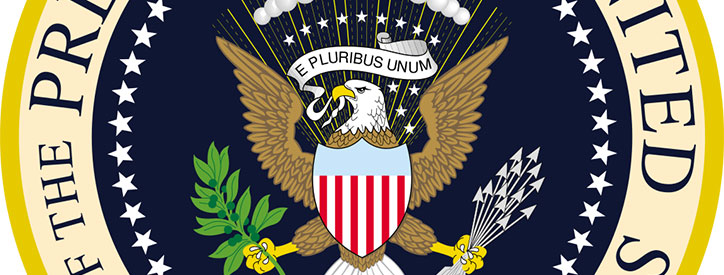 Yesterday, President Obama released his annual budget, outlining the Administration’s policy proposals, budgetary projections, and economic forecasts for the next decade. Although deficits have declined since 2009 during the Great Recession, our nation’s fiscal outlook remains unsustainable. The policy proposals in this budget are not sufficient to stabilize the debt over the long term.
Yesterday, President Obama released his annual budget, outlining the Administration’s policy proposals, budgetary projections, and economic forecasts for the next decade. Although deficits have declined since 2009 during the Great Recession, our nation’s fiscal outlook remains unsustainable. The policy proposals in this budget are not sufficient to stabilize the debt over the long term.
Under the president’s budget:
- Federal debt will remain historically high, roughly double its average over the past 50 years
- Revenues and spending will rise significantly — well above their historical average
- Net interest costs will soar to $785 billion in 2025, more than triple their level in 2014, and total $5.6 trillion over ten years.
The ball is now in Congress’ court as lawmakers start work on the budget resolution for fiscal year 2016. Amidst the strengthening economy, Congress should work with the administration to enact policies that help our economy grow, address our long-term budgetary challenges, make our tax code more efficient, and secure a sustainable economic future. In order to stabilize the debt for the long term, policies must address the key drivers: an aging population, rising health care costs, and an inadequate tax code.
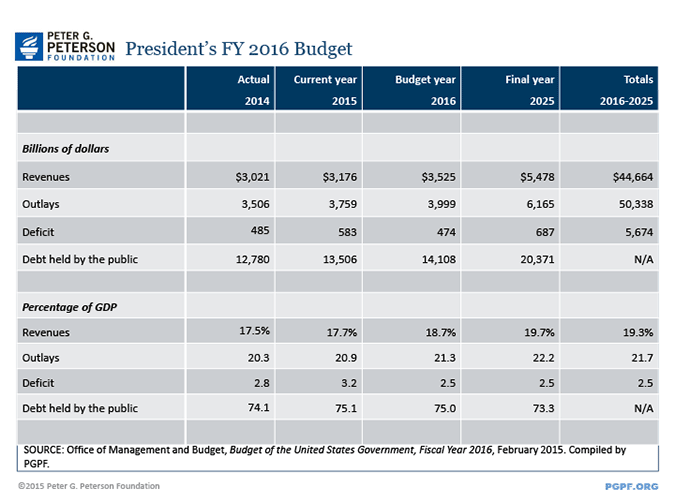
Debt will remain high. Although federal debt is projected to decline slightly over the next decade under the president’s budget, it still remains at historically high levels, and will grow significantly thereafter. Before 2012, debt had never been above 70 percent of GDP except for a few years during and just after World War II. And over the past 50 years, it has averaged only 38 percent of GDP. Under the president’s 2016 budget, debt is projected to remain above 70 percent — roughly twice its 50-year average — over the next 10 years.
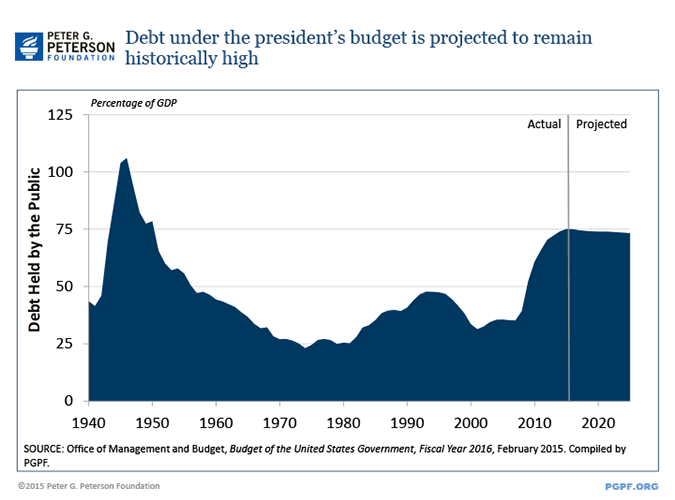
Revenues rise above their historical averages. The president’s budget raises revenues significantly over the next 10 years. Under his plan, revenues will climb to 19.7 percent of GDP by 2025, which is above the 50-year average of 17.4 percent. Outlays will rise to 22.2 percent of GDP in 2025, above the 50-year average of 20.1 percent.
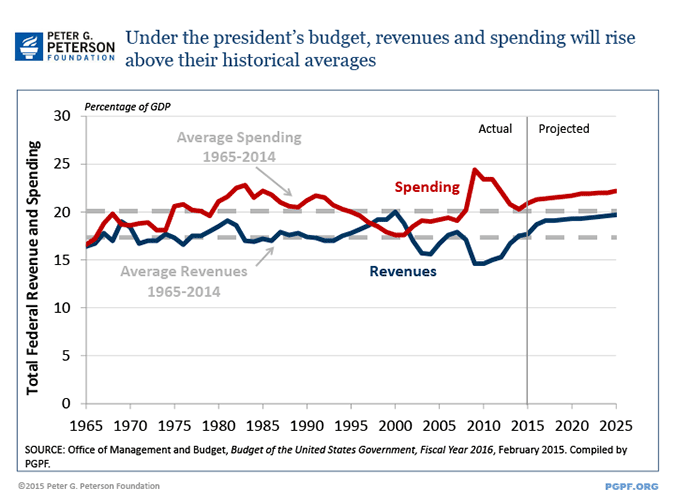
Net interest costs soar. The president’s budget shows interest costs climbing sharply over the next decade as debt continues to accumulate and interest rates rise. Over the next 10 years, net interest costs will more than triple, reaching $785 billion in 2025. In 2022, interest is projected to become the third largest spending category, after only Social Security and Medicare.
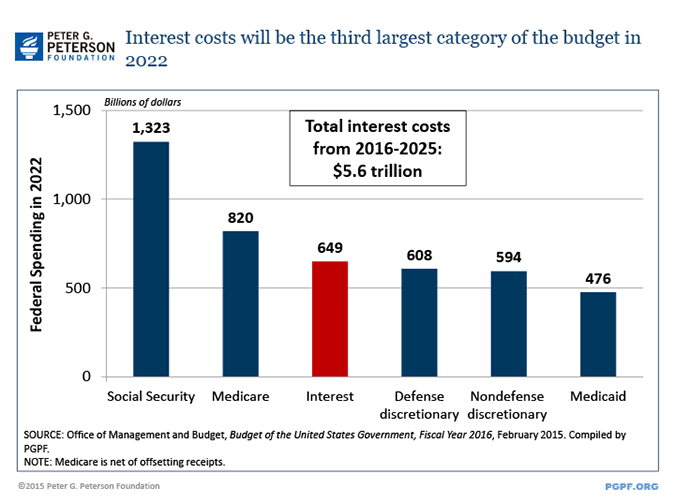
Discretionary programs under pressure. As interest payments and spending on mandatory programs (such as Social Security, Medicare, Medicaid and other health programs) grow under the president’s budget, other important federal activities are placed at increased risk of being crowded out. As a share of the total budget, spending on interest payments and mandatory programs will climb to 78 percent in 2025, up sharply from 61 percent in 2005. Discretionary spending — which includes programs for national defense, homeland security, food and drug safety, science, education, national parks, affordable housing, and infrastructure — will drop to 22 percent in 2025, down from 39 percent in 2005.
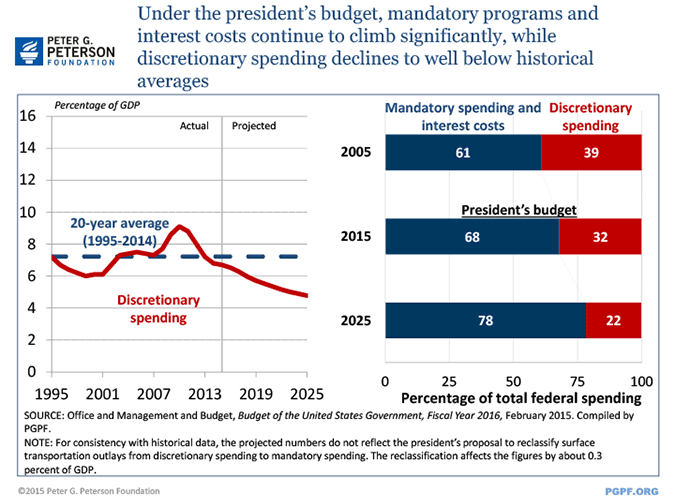
Under the president’s plan, total discretionary spending as a percentage of GDP is estimated to fall from 6.7 in 2015 to 4.8 percent of GDP in 2025, 34 percent lower than the 20-year historical average of 7.2 percent.1 As total discretionary funding falls, funding for R&D, education, infrastructure programs, and other investments face reductions, which could have a negative impact on the economy
Long-term fiscal challenges remain. The president’s budget increases revenue, but it also increases spending and his policies would not do enough to stabilize the debt in the decades ahead. Moreover, the 10-year deficits in his 2016 budget are about $640 billion higher than the deficits in his budget last year. Just two years ago, the president proposed using chained CPI (a more accurate measure of inflation) for indexing entitlement programs and the tax system, a reform that would have improved the long-term fiscal outlook.
In its latest long-term budget outlook (July 2014), the Congressional Budget Office (CBO) projects that, within 25 years, federal debt held by the public would rise under current law to 106 percent of GDP and to 183 percent of GDP under less optimistic assumptions. Debt at those levels would put our economic future at risk.
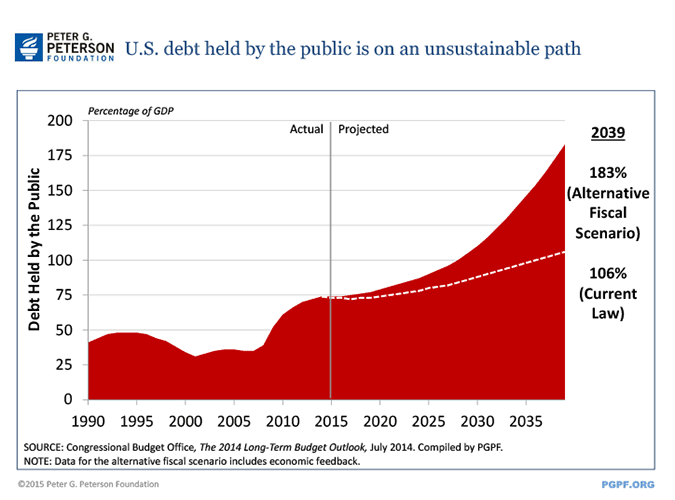
Stabilizing the debt over the long term is a key part of any sound fiscal policy and viable economic strategy for America. Until we confront these budgetary realities and close the structural imbalance between spending and revenues, America’s economy and future prosperity are at risk. We need to address America’s long-term fiscal challenges in order invest in our own future, to protect critically important programs, and ensure economic growth and opportunity for future generations.
Congress and the administration have a new opportunity to tackle our long-term budget challenges. As our economy gains strength, the president and Congress should work together to set sensible budget priorities to address the long-term mismatch between spending and revenues, and put America on a solid fiscal foundation to achieve widespread economic prosperity.
1 For consistency with historical data, the projected 2015 and 2025 spending levels do not reflect the president’s proposal to reclassify surface transportation outlays from discretionary spending to mandatory spending. The reclassification reduces the figures by about 0.3 percent of GDP. (Back to citation)
